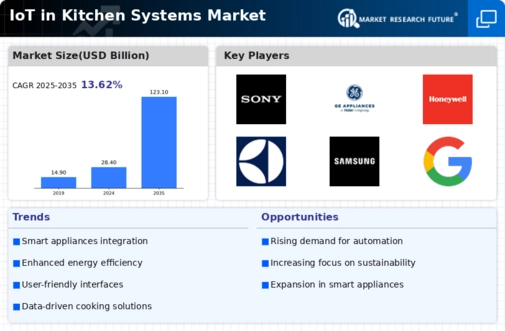Growing Urbanization and Smart Homes
The trend of urbanization and the rise of smart homes are significant drivers of the Global IoT in Kitchen Systems Market Industry. As more individuals move to urban areas, the demand for efficient and space-saving kitchen solutions increases. Smart home technologies, including IoT-enabled kitchen appliances, are becoming integral to modern living. These systems offer enhanced convenience, security, and energy management, appealing to urban dwellers. The market is likely to see accelerated growth as smart home adoption rates rise, with projections indicating a compound annual growth rate of 14.27% from 2025 to 2035.
Sustainability and Energy Efficiency
Sustainability concerns are increasingly influencing consumer choices, thereby impacting the Global IoT in Kitchen Systems Market Industry. Energy-efficient appliances that utilize IoT technology are gaining traction as consumers seek to reduce their carbon footprint. Smart kitchen devices can monitor energy usage and suggest optimal settings, leading to significant savings on utility bills. This trend aligns with global efforts to promote sustainable living, as evidenced by initiatives aimed at reducing energy consumption in households. The market's growth is further supported by regulations encouraging energy-efficient appliances, which could enhance the adoption of IoT solutions in kitchens.
Integration of AI and Machine Learning
The integration of artificial intelligence and machine learning into kitchen systems is a pivotal driver for the Global IoT in Kitchen Systems Market Industry. These technologies enable appliances to learn user preferences and optimize cooking processes, thereby enhancing efficiency. For instance, smart ovens can adjust cooking times and temperatures based on the type of food being prepared. This level of personalization not only improves the cooking experience but also reduces energy consumption. As AI continues to evolve, its application in kitchen systems is likely to expand, contributing to the market's projected growth to 123.1 USD Billion by 2035.
Advancements in Connectivity Technologies
Advancements in connectivity technologies, such as 5G and Wi-Fi 6, are transforming the Global IoT in Kitchen Systems Market Industry. These technologies facilitate seamless communication between devices, enhancing the functionality of smart kitchen systems. With faster data transfer rates and improved reliability, consumers can control multiple appliances simultaneously through their smartphones or voice assistants. This interconnectedness not only simplifies cooking tasks but also allows for real-time updates and notifications. As connectivity continues to improve, the market is expected to benefit from increased adoption rates, further driving growth in the coming years.
Rising Consumer Demand for Smart Appliances
The Global IoT in Kitchen Systems Market Industry experiences a surge in consumer demand for smart appliances, driven by the desire for convenience and efficiency in daily cooking tasks. As households increasingly adopt smart technologies, the market is projected to reach 28.4 USD Billion in 2024. This growing preference for connected devices, such as smart ovens and refrigerators, reflects a shift towards automation in the kitchen. Consumers are drawn to features like remote monitoring and control, which enhance user experience and save time. Consequently, manufacturers are innovating to meet these expectations, further propelling market growth.
























Leave a Comment